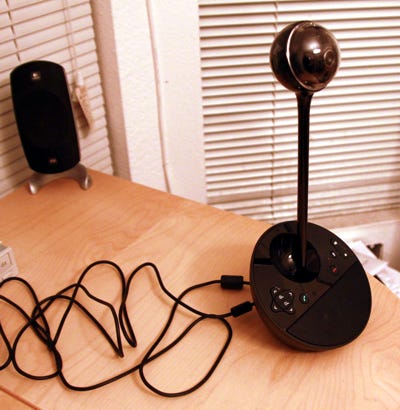Logitech ConferenceCam BCC950: Easy, Quality Videoconferencing
With the exception of a few fixable design flaws, I am very pleased with the Logitech ConferenceCam BCC950. Pair it up with any 40+ inch 1080P HDTV with a VESA mounted fanless embedded computer running Skype and the solution could rival some business class "telepresence" solutions. Not only will you save a ton of money, you will be able to easily reach beyond your own corporate Intranet and avoid all the protocol incompatibilities plaguing the expensive telepresence systems.

In this era of glorified videoconferencing solutions, marketed as "immersive telepresence" and being sold for the price of a home, many businesses and organizations simply want an easy and affordable solution. Logitech's ConferenceCam BCC950, a combination webcam and speakerphone, addresses this market. The ConferenceCam largely delivers on the promise of being easy and affordable but it comes with some minor design annoyances.
Video quality
The most important feature in a product like this is the video quality, and the $249.99 ConferenceCam delivers some of the best webcam video I have ever seen. Though not movie-grade 1080P, it's amazing for a package this small.
In a room well lit with natural light, the camera delivers minimal noise and reasonably detailed 1920x1080 resolution video with smooth frame rates. In low light, the frame rates drop, but the 1080P video still looks good.
The ConferenceCam BCC950 delivers smooth, sharp video.
At $250, the ConferenceCam seems expensive compared to 1080P webcams that are a quarter of the price. But those cheaper alternatives offer less detail or have artifact problems. For instance, as you can see in the sample video below made with my own personal camera, the Creative Live! Socialize HD 720p, the video is nowhere near as sharp as the ConferenceCam's. It's even too pixelated to be considered 720P. (I have not tested the Creative Socialize 1080P.)
The Creative Live! Socialize HD 720p could have smoother video.
Based on the review below, the detail, frame rate, and rolling shutter artifacts of the Microsoft LifeCam Studio 1080P all seem inferior to my Logitech sample, but some of that might be due to inferior lighting. Still, the Logitech ConferenceCam seems to deliver cleaner results in low light and contains the rolling shutter effect better. I will update this comparison when I get a chance to test the Microsoft LifeCam Studio 1080P myself.
Microsoft LifeCam Studio 1080P seems inferior to the Logitech ConferenceCam, especially in low light.
Sound quality
The sound quality of a conferencing solution is arguably more important than video quality because users are less forgiving about audio problems. The speakerphone on the Logitech ConferenceCam BCC950 seems to filter noise and feedback very well. Here's a sample recording of the ConferenceCam BCC950 mic and a noisier sample of the Creative Socialize HD 720P mic.
My only complaint about the BCC950 audio is that the filtering seems to overly compress the dynamic range and bass of the voice. However, that seems like an acceptable tradeoff because noise filtering is crucial for audio conferencing.
Design glitches
The Logitech ConferenceCam has a few design flaws. For instance, the neck that holds up the camera should either be longer, or a flexible cable. This would let you mount the camera above your screen and the speakerphone below it. The way it's set up now forces you to keep the camera to the side of the screen, which makes it difficult to face the camera while looking at the screen.
My biggest objection, though, is having to deal with two separate USB cables, one of which uses a round plug on the speakerphone side. One thick USB cable with an extra power conductor with a second USB connector daisy chained from the first USB connector--a design often found in portable DVD burners--would have been better. Though it's possible to tie the two cables together, it's a step that users should not have to do. [Update:]As a saving grace, the cables do come with convenient Velcro ties to tidy up the wiring. Furthermore, Logitech also provides an AC adapter for plugging the power port into the wall socket.

For the price of the ConferenceCam, Logitech should really offer a consolidated USB cable and an alternative camera mount that allows the camera orb to sit on top of a monitor.
Remote control
The ConferenceCam also comes with a remote to control the mechanical pan, digital zoom, sound, and Skype call functions such as call and hangup. Unfortunately, there is no way to have the arrow buttons serve double duty as a Skype navigation system and you still need a separate mouse to control Skype. That being the case, I would have preferred a way to easily control the camera using a mouse through some hot-button and pop-up interface.
The pan tilts the camera up, down, left, and right with a fair degree of range. Left-right pan is close to 180 degrees but it will not let the camera swing all the way around and see what's behind. Up and down is less than 90 degrees but it offers plenty of coverage for conventional uses.
The digital zoom feature is a bit less useful because it relies on cropping the image sensor and software interpolation to magnify the cropped image. The native lens magnification seems optimal for one person four to five feet away or three people 10 to 15 feet away so digital zoom seems mostly unnecessary.
Name: Logitech ConferenceCam BCC950
With the exception of a few fixable design flaws, the Logitech ConferenceCam BCC950 is a pleasing videocam. Pair it with any 40-inch 1080P HDTV with a VESA mounted fanless embedded computer running Skype and the solution could rival some business class "telepresence" solutions. Not only will you save a ton of money, you will be able to easily reach beyond your own corporate Intranet and avoid all the protocol incompatibilities plaguing the expensive telepresence systems.
Price: $249.99
Pro:
Best 1080P image quality for webcams so far.
Good noise cancellation for clean audio recording.
Good sound output from speakers.
Reasonable price for the quality.
Cons:
Poor cable management.
Remote control design could be better.
Audio recordings sound narrow on frequency response.
Needs alternative mount so camera can be placed on top of monitor.
About the Author
You May Also Like






